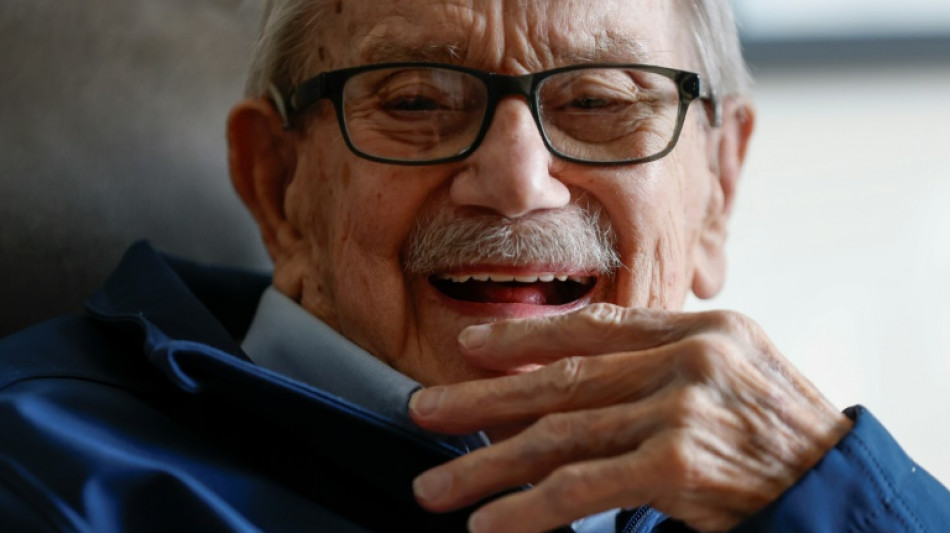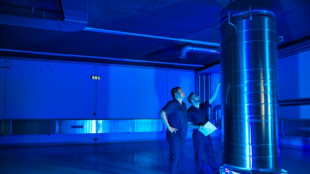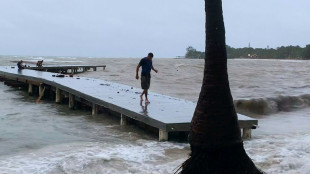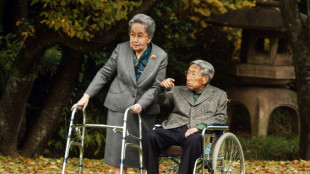
-
 Debt-saddled Laos struggles to tame rampant inflation
Debt-saddled Laos struggles to tame rampant inflation
-
India's vinyl revival finds its groove

-
 Climate finance can be hard sell, says aide to banks and PMs
Climate finance can be hard sell, says aide to banks and PMs
-
Egypt's middle class cuts costs as IMF-backed reforms take hold

-
 Dinosaur skeleton fetches 6 million euros in Paris sale
Dinosaur skeleton fetches 6 million euros in Paris sale
-
Trump's Republican allies tread lightly on Paris pact at COP29

-
 China's Xi urges APEC unity in face of 'protectionism'
China's Xi urges APEC unity in face of 'protectionism'
-
Farmers target PM Starmer in protest against new UK tax rules

-
 UN climate chief urges G20 to spur tense COP29 negotiations
UN climate chief urges G20 to spur tense COP29 negotiations
-
Philippines warns of 'potentially catastrophic' Super Typhoon Man-yi

-
 Tens of thousands flee as Super Typhoon Man-yi nears Philippines
Tens of thousands flee as Super Typhoon Man-yi nears Philippines
-
Gabon votes on new constitution hailed by junta as 'turning point'

-
 Tens of thousands flee as Typhoon Man-yi nears Philippines
Tens of thousands flee as Typhoon Man-yi nears Philippines
-
Is Argentina's Milei on brink of leaving Paris climate accord?

-
 Fitch upgrades Argentina debt rating amid economic pain
Fitch upgrades Argentina debt rating amid economic pain
-
Trump picks Doug Burgum as energy czar in new administration

-
 At summit under Trump shadow, Xi and Biden signal turbulence ahead
At summit under Trump shadow, Xi and Biden signal turbulence ahead
-
Xi warns against 'protectionism' at APEC summit under Trump cloud

-
 Xi, Biden at Asia-Pacific summit under Trump trade war cloud
Xi, Biden at Asia-Pacific summit under Trump trade war cloud
-
Leftist voices seek to be heard at Rio's G20 summit

-
 Boeing strike will hurt Ethiopian Airlines growth: CEO
Boeing strike will hurt Ethiopian Airlines growth: CEO
-
US retail sales lose steam in October after hurricanes

-
 Spate of child poisoning deaths sparks S.Africa xenophobia
Spate of child poisoning deaths sparks S.Africa xenophobia
-
Comedian Conan O'Brien to host Oscars

-
 Gore says 'absurd' to hold UN climate talks in petrostates
Gore says 'absurd' to hold UN climate talks in petrostates
-
Global stocks struggle after Fed signals slower rate cuts

-
 China tests building Moon base with lunar soil bricks
China tests building Moon base with lunar soil bricks
-
Oil execs work COP29 as NGOs slam lobbyist presence

-
 Gore says climate progress 'won't slow much' because of Trump
Gore says climate progress 'won't slow much' because of Trump
-
'Megaquake' warning hits Japan's growth

-
 Stiff business: Berlin startup will freeze your corpse for monthly fee
Stiff business: Berlin startup will freeze your corpse for monthly fee
-
Dominican Juan Luis Guerra triumphs at 25th annual Latin Grammys

-
 Tropical Storm Sara pounds Honduras with heavy rain
Tropical Storm Sara pounds Honduras with heavy rain
-
TikTok makes AI driven ad tool available globally

-
 Japan growth slows as new PM readies stimulus
Japan growth slows as new PM readies stimulus
-
China retail sales pick up speed, beat forecasts in October

-
 Pakistan's policies hazy as it fights smog
Pakistan's policies hazy as it fights smog
-
Mexico City youth grapple with growing housing crisis

-
 Cracks deepen in Canada's pro-immigration 'consensus'
Cracks deepen in Canada's pro-immigration 'consensus'
-
Japan's Princess Mikasa, great aunt to emperor, dies aged 101

-
 Venezuela opposition activist dies in custody
Venezuela opposition activist dies in custody
-
Policymakers defend Fed independence amid concerns about Trump era

-
 Lebanon economic losses top $5 billion in year of clashes: World Bank
Lebanon economic losses top $5 billion in year of clashes: World Bank
-
Fed Chair calls US the best-performing major economy in the world

-
 Brother of late Harrods owner also accused of sexual violence: BBC
Brother of late Harrods owner also accused of sexual violence: BBC
-
New York to revive driver congestion charge plan, drawing Trump ire

-
 China's Xi arrives in Peru for APEC summit, Biden meeting
China's Xi arrives in Peru for APEC summit, Biden meeting
-
Spain's Vanguardia daily to stop posting on 'disinformation network' X

-
 New York to revive driver congestion charge plan
New York to revive driver congestion charge plan
-
US stocks wobble as traders weigh future Fed cuts


For US veteran, D-Day memories still vivid after 80 years
Richard Rung recalls it vividly: German artillery firing on his landing craft, the sound of machine gun bullets striking the vessel, blood mixed with seawater on the deck, troops crying on the beach.
It has been nearly eight decades since Rung landed in France on D-Day -- June 6, 1944 -- as a 19-year-old US Navy sailor, part of a massive amphibious invasion that broke through German coastal defenses in a key victory for Allied forces.
He now lives in a suburb of Chicago with Dorothy, his wife of 75 years, but his memories of the violence and death he witnessed half a world away are still clear, and that distant day can still feel close at hand.
"D-Day is not always, you know, a long way off," said Rung, a gray-haired, mustachioed 99-year-old wearing a blue jacket with the US Navy emblem.
"Sometimes, it's yesterday," he said. "When you have these experiences, they come back to you if you get a right situation."
- 'They opened up' -
Rung's path to Normandy began when he was drafted in 1943, choosing the Navy on the advice of his father, who urged him to "take the Navy. At least you'll be at sea, you have something to eat."
He dreamed of serving on a destroyer, but was assigned to maintain the engine on a landing craft because of his knowledge of motors gained in vocational school -- a turn of events that brought him to France.
Rung trained in the United States and then traveled by ship to Britain, where he witnessed German planes bombing London.
"Every night, they were raided," he said.
After crossing the English Channel, Rung's landing craft hit Omaha Beach as part of the second wave on D-Day, coming under heavy German artillery and machine gun fire.
"We dropped the ramp at 7:30... and they opened up on us," he said.
- 'Get down!' -
Despite the danger, he tried to see what was unfolding -- to his skipper's chagrin.
"He looked down and he said, 'Dick, get down!' I wanted to see," said Rung, who remembered hearing bullets hitting the side of the landing craft as he looked at the beach.
"The machine guns were terrible," he said. "I'll never forget the machine guns."
The ship's log -- copied in Rung's diary -- provides a clipped, military account of the landing.
"0730 Hit beach. It being well guarded received two shells from 88mm. One in starboard locker, one in skipper's quarters, one 47mm hole in starboard bulwark. Two soldiers killed two badly hurt. One 47mm through port ramp extension."
Four minutes later, the landing craft pulled back and went in search of a better site, but other spots were also heavily guarded.
Finding a location and unloading the vessel took hours, but that mission had to be completed before the wounded could be taken to a hospital ship.
- 'It was terrible' -
Rung said the landing craft's deck was "flowing in blood" from troops who were hit mixed with seawater that entered when the ramp was lowered, which crew members had to clean off later in the day.
He also recalled seeing the bodies of fallen troops and "guys... crying on the beach. It was terrible."
The landing craft carried a bulldozer for mine-clearing, but "he never made it," Rung said. "He got to the beach -- I found this out the next morning -- he hit a mine."
"If they didn't get hit with a rifle, (they) could easily step on a mine," he said.
Two days after D-Day, Rung made a gruesome discovery while ashore.
"That's when I found this big pile of arms and legs," he said, wondering how it would be possible to identify someone from those remains.
- 'Peace, not war' -
After more than two months in Normandy, Rung was sent to the Pacific, and was at Leyte Harbor in the Philippines when Japan formally surrendered on September 2, 1945.
"Nobody can imagine what a great feeling it gave us to see and know that the war was over and that the thing we have been fighting so long and hard for had finally come to pass," he wrote in his diary.
Rung was honorably discharged from the Navy in 1946, going to college with funding from the GI Bill and later teaching history and political science as a professor.
He initially "didn't say much" about his World War II experiences, thinking that might be better, but "that's a mistake," he said.
"A guy that says, 'I don't want to talk about it' -- he needs to talk about it."
Rung still sometimes speaks to high school students, urging them to "work for peace, not war."
"I want them to be conscious of the fact that being a peacemaker is the way to go," he said.
P.Petrenko--CPN
